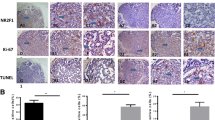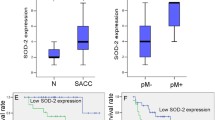Abstract
Salivary Adenoid Cystic Carcinoma (SACC) is a tumor characterized by inevitable local progression and terminal hematogenous metastasis. This study aimed to investigate the expression of LC3, LAMP2, KEAP1 and NRF2 in SACC. Human salivary gland tissue microarray which contains 74 SACC, 12 pleomorphic adenoma and 18 normal salivary gland specimens. High expression of LC3, LAMP2, KEAP1 and NRF2 were found in SACC patients, and LC3, LAMP2, KEAP1 and NRF2 expression were significantly higher in SACC than as compared with pleomorphic adenoma and (or) normal salivary gland. The expression of NRF2 was correlated with pathological type of human SACC (P < 0.05). Moreover, the high-expression of KEAP1 had significant correlations with LC3 (P < 0.001, R = 0.3195), and LAMP2 (P < 0.001, R = 0.3346) and NRF2 (P < 0.05, R = 0.2246) by using the Pearson correlation coefficient test. Our findings demonstrated that up-regulation of LC3, LAMP2, KEAP1 and NRF2 were associated with carcinogenesis and progression of SACC patients, suggesting that they may be useful molecular targets in salivary adenoid cystic carcinoma.





Similar content being viewed by others
References
Wang YF, Zhang W, He KF, Liu B, Zhang L, et al. (2014) Induction of autophagy-dependent cell death by the survivin suppressant YM155 in salivary adenoid cystic carcinoma. Apoptosis 19:748–758
Tang QL, Fan S, Li HG, Chen WL, Shen XM, et al. (2011) Expression of Cyr61 in primary salivary adenoid cystic carcinoma and its relation to Ki-67 and prognosis. Oral Oncol 47:365–370
Munafo DB, Colombo MI (2001) A novel assay to study autophagy: regulation of autophagosome vacuole size by amino acid deprivation. J Cell Sci 114:3619–3629
Meijer AJ, Dubbelhuis PF (2004) Amino acid signalling and the integration of metabolism. Biochem Biophys Res Commun 313:397–403
Klionsky DJ, Abeliovich H, Agostinis P, Agrawal DK, Aliev G, et al. (2008) Guidelines for the use and interpretation of assays for monitoring autophagy in higher eukaryotes. Autophagy 4:151–175
Saha T (2012) LAMP2A overexpression in breast tumors promotes cancer cell survival via chaperone-mediated autophagy. Autophagy 8:1643–1656
Fehrenbacher N, Bastholm L, Kirkegaard-Sorensen T, Rafn B, Bottzauw T, et al. (2008) Sensitization to the lysosomal cell death pathway by oncogene-induced down-regulation of lysosome-associated membrane proteins 1 and 2. Cancer Res 68:6623–6633
Miracco C, Cevenini G, Franchi A, Luzi P, Cosci E, et al. (2010) Beclin 1 and LC3 autophagic gene expression in cutaneous melanocytic lesions. Hum Pathol 41:503–512
Tang JY, Hsi E, Huang YC, Hsu NC, Chu PY, et al. (2013) High LC3 expression correlates with poor survival in patients with oral squamous cell carcinoma. Hum Pathol 44:2558–2562
Eskelinen EL (2011) The dual role of autophagy in cancer. Curr Opin Pharmacol 11:294–300
Valko M, Rhodes CJ, Moncol J, Izakovic M, Mazur M (2006) Free radicals, metals and antioxidants in oxidative stress-induced cancer. Chem Biol Interact 160:1–40
Takaya K, Suzuki T, Motohashi H, Onodera K, Satomi S, et al. (2012) Validation of the multiple sensor mechanism of the Keap1-Nrf2 system. Free Radic Biol Med 53:817–827
Leinonen HM, Kansanen E, Polonen P, Heinaniemi M, Levonen AL (2014) Role of the keap1-nrf2 pathway in cancer. Adv Cancer Res 122:281–320
Huang CF, Zhang L, Ma SR, Zhao ZL, Wang WM, et al. (2013) Clinical significance of Keap1 and Nrf2 in oral squamous cell carcinoma. PLoS One 8: e83479
Liu C, Xu P, Chen D, Fan X, Xu Y, et al. (2013) Roles of autophagy-related genes beclin-1 and LC3 in the development and progression of prostate cancer and benign prostatic hyperplasia. Biomed Rep 1:855–860
Jiang L, Huang S, Li W, Zhang D, Zhang S, et al. (2012) Expression of autophagy and ER stress-related proteins in primary salivary adenoid cystic carcinoma. Pathol Res Pract 208:635–641
Mello AS, Goldim MP, Mezzalira J, Garcia CS, Daitx VV, et al. (2014) LAMP2 as a marker of EBV-mediated B lymphocyte transformation in the study of lysosomal storage diseases. Mol Cell Biochem 385:1–6
Kansanen E, Kuosmanen SM, Leinonen H, Levonen AL (2013) The Keap1-Nrf2 pathway: mechanisms of activation and dysregulation in cancer. Redox Biol 1:45–49
Suzuki T, Motohashi H, Yamamoto M (2013) Toward clinical application of the Keap1-Nrf2 pathway. Trends Pharmacol Sci 34:340–346
Lister A, Nedjadi T, Kitteringham NR, Campbell F, Costello E, et al. (2011) Nrf2 is overexpressed in pancreatic cancer: implications for cell proliferation and therapy. Mol Cancer 10:37
Gonzalez-Polo RA, Boya P, Pauleau AL, Jalil A, Larochette N, et al. (2005) The apoptosis/autophagy paradox: autophagic vacuolization before apoptotic death. J Cell Sci 118:3091–3102
Tanida I, Tanida-Miyake E, Ueno T, Kominami E (2001) The human homolog of Saccharomyces cerevisiae Apg7p is a protein-activating enzyme for multiple substrates including human Apg12p, GATE-16, GABARAP, and MAP-LC3. J Biol Chem 276:1701–1706
Gonzalez Y, Aryal B, Chehab L, Rao VA (2014) Atg7- and Keap1-dependent autophagy protects breast cancer cell lines against mitoquinone-induced oxidative stress. Oncotarget 5:1526–1537
Huber S, Valente S, Chaimbault P, Schohn H (2014) Evaluation of 2-pioglitazone, an analogue of pioglitazone, on colon cancer cell survival: evidence of drug treatment association with autophagy and activation of the Nrf2/Keap1 pathway. Int J Oncol 45:426–438
Acknowledgments
This study was supported by the National Natural Science Foundation of China 81072203, 81272963, 81472528 (ZJS), 81272964, 81472529 (WFZ), 81402241 (CFH) and the Fundamental Research Funds for the Central Universities (2042014kf0095).
Conflict of Interest Statement
The authors have declared that no competing interests exist.
Author information
Authors and Affiliations
Corresponding authors
Additional information
Cong-Fa Huang and Wei-Wei Deng contributed equally to this work.
Rights and permissions
About this article
Cite this article
Huang, CF., Deng, WW., Zhang, L. et al. Expression of LC3, LAMP2, KEAP1 and NRF2 in Salivary Adenoid Cystic Carcinoma. Pathol. Oncol. Res. 22, 109–114 (2016). https://doi.org/10.1007/s12253-015-9981-0
Received:
Accepted:
Published:
Issue Date:
DOI: https://doi.org/10.1007/s12253-015-9981-0




